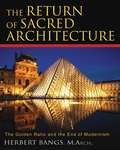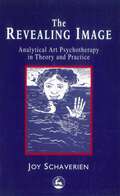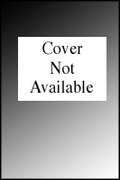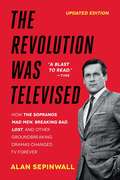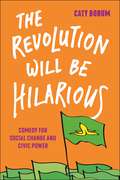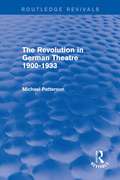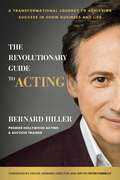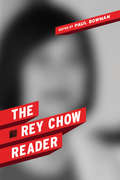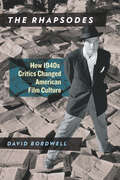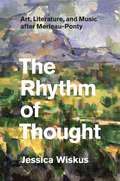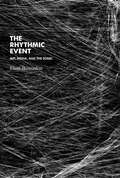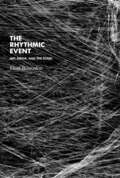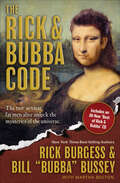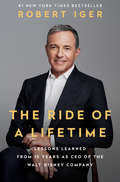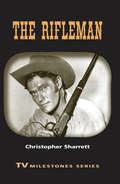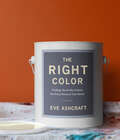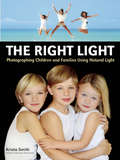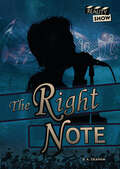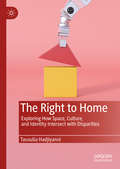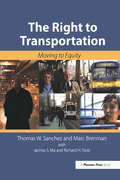- Table View
- List View
The Return of Sacred Architecture: The Golden Ratio and the End of Modernism
by Herbert BangsAn inspirational call for a return to the tenets of traditional architecture as a remedy for the dehumanizing standards of modern architecture • Explains how modern architecture is emblematic of our current estrangement from the spiritual principles that shaped humanity’s greatest civilizations • Reveals how the ancient laws of sacred proportion and harmony can be restored The ugly buildings that characterize the modern landscape are inferior not only to the great cathedrals of medieval Europe and the temples of ancient Egypt and Greece, but even to lesser buildings of the more recent past. The great masterworks of our ancestors spoke to humanity’s higher nature. Architect Herbert Bangs reveals how today’s dysfunctional buildings bring out the worst in humanity, reinforcing that which is most base within us. He shows how, through the ancient laws of proportion and number, architecture once expressed the harmonious relationship between man and the cosmos. In early times, the architect worked within a sacred and esoteric tradition of creating structures through which human beings could gain insight into the nature of the divine reality. Today, that tradition has been abandoned in favor of narrowly defined utilitarian principles of efficiency and economy. In The Return of Sacred Architecture, Bangs provides the key to freeing architecture from the crude functionality of the twentieth century: the architects of the modern human landscape must find the deep-felt connection to the cosmos that guided the inner lives of those who built the temples of the past. The form of their buildings will then reflect the sacred patterns of geometry and proportion and bring forth greater harmony in the world.
The Revealing Image: Analytical Art Psychotherapy in Theory and Practice
by Joy SchaverienSchaverien painstakingly describes and defines "processes which have so far only been intuitively known to art therapists" (p6) by introducing and elaborating the psychoanalytical concepts of transference and countertransference in relation to the use of visual art objects. The authors stated intention in this book is "to attempt to bridge the perceived gap between the practice of art therapy and analytical forms of psychotherapy..."(p 229) The epistemological base of this venture includes the fields of philosophy, anthropology, and aesthetics, as well as psychoanalysis.Schaverien suggests that analytical art psychotherapy is a way of working analytically with patients who are unsuitable, or unready, for psychotherapy, giving examples of psychotic and borderline patients, children, and patients in psychiatric settings.This is primarily a book about an analytical approach within art therapy, which may be of interest in itself. The material also raises issues of interest to analysts and psychotherapists, whether or not they work with art in the clinical setting. The book clarifies areas of similarity between the disciplines, and also makes areas of difference apparent. For example, most analysts would agree that visual art, like dream material, and other non-verbal representations of the inner world, can at times articulate and communicate meanings which for one reason or another cannot be verbally articulated at the time, and that this can be pertinent to the aim of analysis. However, I think few analysts would include facilities in their consulting rooms for the kind of art processes described in the book.When the analyst is working with materials in this form, the book will be extremely helpful in sorting out the complexity of the transference situation and the role of interpretation. The book is so strongly grounded in experiences emerging in the presence of actual art processes and objects that I think it will be of most interest to those who are interested in the specific clinical issues involved in relating to the making and use of actual art objects within the setting. Schaverien not only describes the processes involved in detail, but also presents technical approaches to the making and handling of art objects within the setting which will inform the capacity of those who are not trained as art therapists to relate to this kind of material in the consulting room.'
The Reverend Billy Project: From Rehearsal Hall to Super Mall with the Church of Life After Shopping
by Bill Talen Savitri DReverend Billy, the revivalist preacher created by performance artist Bill Talen, has attracted an international following as he has railed in white suit and clerical collar against the evils of excessive consumerism and corporate irresponsibility. In his early solo performances in Times Square he delivered sermons by megaphone against Starbucks and the Disney Store; as his message and popularity spread, he's been joined by a 35-member choir (the Life After Shopping Gospel Choir) and a 7-piece band. The group's acclaimed stage show and media appearances (including a major motion picture,What Would Jesus Buy?) have reached millions. The Reverend Billy Project presents backstage accounts of recent performance actions by Reverend Billy and the troupe's director, Savitri D, recounting their exploits on three continents in vivid narratives that are engaging, shrewdly analytical, and at times side-splittingly funny. We watch as the group plans invisible theater interventions in Starbucks, designs a mermaid hunger strike to thwart gentrification plans for Coney Island, and makes an extended effort to preserve the public nature of New York's Union Square. We follow them to an action camp in Iceland and a flop of a show redeemed by a successful impromptu demonstration in a Berlin shopping mall. As thoughtful as they are funny and inventive, Reverend Billy and Savitri D's story-essays bring to life a playful yet sincere new form of political theater. "The Reverend Billy Project lucidly and perceptively explains the Reverend Billy phenomenon with wry, infectious humor and remarkable intelligence. Though many political activists have used theater and performance to achieve political ends, very few have left such articulate reports on what they did, let alone detailed road maps of the treacherous theatrical, political, and psychological territory they negotiated." ---Jonathan Kalb, Hunter College.
The Revival of Beauty: Aesthetics, Experience, and Philosophy (Routledge Research in Aesthetics)
by Catherine WesselinoffThis book provides original descriptive accounts of two schools of thought in the philosophy of beauty: the 20th-century “Anti-Aesthetic” movement and the 21st-century “Beauty Revival” movement. It also includes a positive defence of beauty as a lived experience extrapolated from Beauty-Revival position. Beauty was traditionally understood in the broadest sense as a notion that engages our sense perception and embraces everything evoked by that perception, including mental products and affective states. This book constructs and places in parallel with one another the Anti-Aesthetic and Beauty-Revival movements. In the author’s view, Anti-Aestheticism is devoted to a decisive negation of beauty—denying its importance as a philosophical notion and its significance as a lived experience. It suggests that beauty is a merely sensual experience, which can be used, at best, as a distraction from justice and, at worst, as an instrument of evil. Alternatively, the Beauty-Revival movement advances arguments for beauty as an experience that extends primarily to sensual experience, but which also calls forth mental products and cognitive and affective states evoked by that experience. After reconstructing these two positions, the author elaborates on the notion of beauty as a lived experience through three key moments which occur in the process of our experiencing beautiful objects. These moments are (a) the conditions that constitute an experience of beauty, (b) the attitudinal features most likely to lead to the experience of beauty, and (c) the results of the experience of beauty. The Revival of Beauty will be of interest to scholars and advanced students working in aesthetics, history of philosophy, and art history.
The Revival of Beauty: Aesthetics, Experience, and Philosophy (Routledge Research in Aesthetics)
by Catherine WesselinoffThis book provides original descriptive accounts of two schools of thought in the philosophy of beauty: the 20th-century “Anti-Aesthetic” movement and the 21st-century “Beauty Revival” movement. It also includes a positive defence of beauty as a lived experience extrapolated from Beauty-Revival position.Beauty was traditionally understood in the broadest sense as a notion that engages our sense perception and embraces everything evoked by that perception, including mental products and affective states. This book constructs and places in parallel with one another the Anti-Aesthetic and Beauty-Revival movements. In the author’s view, Anti-Aestheticism is devoted to a decisive negation of beauty—denying its importance as a philosophical notion and its significance as a lived experience. It suggests that beauty is a merely sensual experience, which can be used, at best, as a distraction from justice and, at worst, as an instrument of evil. Alternatively, the Beauty-Revival movement advances arguments for beauty as an experience that extends primarily to sensual experience, but which also calls forth mental products and cognitive and affective states evoked by that experience. After reconstructing these two positions, the author elaborates on the notion of beauty as a lived experience through three key moments which occur in the process of our experiencing beautiful objects. These moments are (a) the conditions that constitute an experience of beauty, (b) the attitudinal features most likely to lead to the experience of beauty, and (c) the results of the experience of beauty.The Revival of Beauty will be of interest to scholars and advanced students working in aesthetics, history of philosophy, and art history.
The Revolution Takes Form: Art and the Barricade in Nineteenth-Century France
by Jordan Marc RoseDuring the French Revolution of 1830, insurgents raised some four thousand barricades. Afterward, lithographs of the street fighting flowed from the presses, creating the barricade’s first imagery. This book documents the changing political valence of the revolutionary ideals associated with the barricade in France from 1830 to 1852.The Revolution Takes Form coordinates the political reality of the barricade with the divergent ways in which its image gave shape to the period’s conceptions of class, revolution, and urban space. Engaging the instability of the barricade, art historian Jordan Marc Rose focuses on five politically charged works of art: Eugène Delacroix’s La Liberté guidant le peuple, Honoré Daumier’s Rue Transnonain, le 15 avril 1834 and L’Émeute, Auguste Préault’s Tuerie, and Ernest Meissonier’s Souvenir de guerre civile. The history of these artworks illuminates how such revolutionary insurrections were characterized—along with the conceptions of “the people” they mobilized. Foregrounding a trajectory of disillusionment, growing class tensions, and ultimately open conflict between bourgeois liberals and the proletariat, Rose both explains why the barricade became a compelling subject for pictorial reflection and accounts for its emergence as the period’s most poignant and meaningful symbol of revolution.Original and convincing, this book will appeal to students and scholars of art history and, in particular, of the history of the French Revolution.
The Revolution Was Televised: The Cops, Crooks, Slingers, and Slayers Who Change
by Alan SepinwallA phenomenal account, newly updated, of how twelve innovative television dramas transformed the medium and the culture at large, featuring Sepinwall's take on the finales of Mad Men and Breaking Bad.In The Revolution Was Televised, celebrated TV critic Alan Sepinwall chronicles the remarkable transformation of the small screen over the past fifteen years. Focusing on twelve innovative television dramas that changed the medium and the culture at large forever, including The Sopranos, Oz, The Wire, Deadwood, The Shield, Lost, Buffy the Vampire Slayer, 24, Battlestar Galactica, Friday Night Lights, Mad Men, and Breaking Bad, Sepinwall weaves his trademark incisive criticism with highly entertaining reporting about the real-life characters and conflicts behind the scenes. Drawing on interviews with writers David Chase, David Simon, David Milch, Joel Surnow and Howard Gordon, Damon Lindelof and Carlton Cuse, and Vince Gilligan, among others, along with the network executives responsible for green-lighting these groundbreaking shows, The Revolution Was Televised is the story of a new golden age in TV, one that's as rich with drama and thrills as the very shows themselves.
The Revolution Will Be Hilarious: Comedy for Social Change and Civic Power (Postmillennial Pop #29)
by Caty BorumAn insider’s look at the power of comedy to effect social changeFrom Trevor Noah’s The Daily Show and Hasan Minhaj’s Patriot Act, to Issa Rae’s Insecure and Corey Ryan Forrester’s Twitter feed, today’s multi-platform comedy refuses to shy away from the social issues that define our time.As more comedians lean into social justice activism, they help reshape the entertainment industry and offer creative, dynamic avenues for social change. The Revolution Will Be Hilarious offers a compelling insider’s look at how comedy and social justice activists are working together in a revolutionary media moment. Caty Borum invites readers into an expanding, enterprising arena of participatory culture and politics through in-depth interviews with comedians, social justice leaders, and Hollywood players. Their insights shed light on questions such as: What role does comedy play in helping communities engage the public with challenging social issues? How do social justice organizations and comedians co-create entertaining comedy designed to build the civic power of marginalized groups? And how are entertainment industry leaders working with social justice organizations to launch new comedy as both entertainment and inspiration for social change?Through this exploration, Borum argues that building creative power is crucial for marginalized groups to build civic power. The Revolution Will Be Hilarious positions the rise of social justice comedy as creative, disruptive storytelling that hilariously invites us to agitate the status quo and re-imagine social realities to come closer to the promise of equity and justice in America.
The Revolution in German Theatre 1900-1933 (Routledge Revivals)
by Michael PattersonFirst published in 1981, this book represents the first work in English to give a comprehensive account of the revolutionary developments in German theatre from the decline of Naturalism through the Expressionist upheaval to the political theatre of Piscator and Brecht. Early productions of Kaiser’s From Morning till Midnight and Toller’s Transfiguration are presented as examples of Expressionism. A thorough analysis of Piscator’s Hoppla, Such is Life! And Brecht’s Man show the similarities and differences in political theatre. In addition, elements of stage-craft are examined — illustrated with tabulated information, an extensive chronology, and photographs and designs of productions.
The Revolutionary Guide to Acting: A Transformational Journey to Achieving Success in Show Business and Life
by Bernard HillerBecome the actor you must be to turn your dreams into reality. For over 25 years, Bernard Hiller&’s revolutionary techniques and exercises have produced unprecedented success for actors, artists, and performers all around the world. Acting is always evolving, and in The Revolutionary Guide to Acting Bernard shares the latest methods to help you gain vital skills for success in this competitive industry. Set yourself apart at your next audition by using Bernard&’s unique techniques, and uncover the secrets to delivering unforgettable performances. Acting is a journey to self-awareness that will lead you to discover your true authenticity, empowering you to become unstoppable in show business. Cultivate the tools you will need for a long-lasting career and, ultimately, a more accomplished and happier life.
The Rey Chow Reader
by Rey ChowRey Chow is arguably one of the most prominent intellectuals working in the humanities today. Characteristically confronting both entrenched and emergent issues in the interlocking fields of literature, film and visual studies, sexuality and gender, postcolonialism, ethnicity, and cross-cultural politics, her works produce surprising connections among divergent topics at the same time as they compel us to think through the ethical and political ramifications of our academic, epistemic, and cultural practices. This anthology - the first to collect key moments in Chow's engaging thought - provides readers with an ideal introduction to some of her most forceful theoretical explorations. Organized into two sections, each of which begins with a brief statement designed to establish linkages among various discursive fields through Chow's writings, the anthology also contains an extensive Editor's Introduction, which situates Chow's work in the context of contemporary critical debates. For all those pursuing transnational cultural theory and cultural studies, this book is an essential resource.
The Rhapsodes: How 1940s Critics Changed American Film Culture
by David BordwellPauline Kael, Andrew Sarris, and Roger Ebert were three of America's most revered and widely read film critics, more famous than many of the movies they wrote about. But their remarkable contributions to the burgeoning American film criticism of the 1960s and beyond were deeply influenced by four earlier critics: Otis Ferguson, James Agee, Manny Farber, and Parker Tyler. Throughout the 1930s and '40s, Ferguson, Agee, Farber, and Tyler scrutinized what was on the screen with an intensity not previously seen in popular reviewing. Although largely ignored by the arts media of the day, they honed the sort of serious discussion of films that would be made popular decades later by Kael, Sarris, Ebert and their contemporaries. With The Rhapsodes, renowned film scholar and critic David Bordwell--an heir to both those legacies--restores to a wider audience the work of Ferguson, Agee, Farber, and Tyler, critics he calls the "Rhapsodes" for the passionate and deliberately offbeat nature of their vernacular prose. Each broke with prevailing currents in criticism in order to find new ways to talk about the popular films that contemporaries often saw at best as trivial, at worst as a betrayal of art. Ferguson saw in Hollywood an engaging, adroit mode of popular storytelling. Agee sought in cinema the lyrical epiphanies found in romantic poetry. Farber, trained as a painter, brought a pictorial intelligence to bear on film. A surrealist, Tyler treated classic Hollywood as a collective hallucination that invited both audience and critic to find moments of subversive pleasure. With his customary clarity and brio, Bordwell takes readers through the relevant cultural and critical landscape and considers the critics' writing styles, their conceptions of films, and their quarrels. He concludes by examining the profound impact of Ferguson, Agee, Farber, and Tyler on later generations of film writers. The Rhapsodes allows readers to rediscover these remarkable critics who broke with convention to capture what they found moving, artful, or disappointing in classic Hollywood cinema and explores their robust--and continuing--influence.
The Rhythm of Images: Cinema beyond Measure (Cultural Critique Books)
by Domietta TorlascoA rigorous and imaginative inquiry into rhythm&’s vital importance for film and the moving imageFocusing attention on a concept much neglected in the study of film, The Rhythm of Images opens new possibilities for thinking about expanded perception and idiosyncratic modes of being. Author Domietta Torlasco engages with both philosophy and cinema to elaborate a notion of rhythm in its pre-Socratic sense as a &“manner of flowing&”—a fugitive mode that privileges contingency and calls up the forgotten fluidity of forms. In asking what it would mean to take this rhythm as an ontological force in its own right, she creatively draws on thinkers such as Giorgio Agamben, Roland Barthes, Gilles Deleuze, and Luce Irigaray. Rhythm emerges here as a form that eludes measure, a key to redefining the relation between the aesthetic and the political, and thus a pivotal means of resistance to power.Working with constellations of films and videos by international artists—from Michelangelo Antonioni, Jean-Luc Godard, and David Lynch to Harun Farocki and Victor Burgin, among others—Torlasco brings to bear on them her distinctive concept of rhythm with respect to four interrelated domains: life, labor, memory, and medium. With innovative readings of artworks and critical texts alike, The Rhythm of Images fashions a vibrant, provocative theory of rhythm as the excess or potential of perception. Ultimately, the book reconceives the relation between rhythm and the world-making power of images. The result is a vision of cinema as a hybrid medium endowed with the capacity not only to reinvent corporeal boundaries but also to find new ways of living together.
The Rhythm of Thought: Art, Literature, and Music after Merleau-Ponty
by Jessica WiskusBetween present and past, visible and invisible, and sensation and idea, there is resonance--so philosopher Maurice Merleau-Ponty argued and so Jessica Wiskus explores in The Rhythm of Thought. Holding the poetry of Stéphane Mallarmé, the paintings of Paul Cézanne, the prose of Marcel Proust, and the music of Claude Debussy under Merleau-Ponty's phenomenological light, she offers innovative interpretations of some of these artists' masterworks, in turn articulating a new perspective on Merleau-Ponty's philosophy. More than merely recovering Merleau-Ponty's thought, Wiskus thinks according to it. First examining these artists in relation to noncoincidence--as silence in poetry, depth in painting, memory in literature, and rhythm in music--she moves through an array of their artworks toward some of Merleau-Ponty's most exciting themes: our bodily relationship to the world and the dynamic process of expression. She closes with an examination of synesthesia as an intertwining of internal and external realms and a call, finally, for philosophical inquiry as a mode of artistic expression. Structured like a piece of music itself, The Rhythm of Thought offers new contexts in which to approach art, philosophy, and the resonance between them.
The Rhythmic Event
by Eleni IkoniadouAn investigation into the affective modes of perception, temporality, and experience enabled by experimental new media sonic art.
The Rhythmic Event: Art, Media, and the Sonic (Technologies of Lived Abstraction)
by Eleni IkoniadouAn investigation into the affective modes of perception, temporality, and experience enabled by experimental new media sonic art. The sonic has come to occupy center stage in the arts and humanities. In the age of computational media, sound and its subcultures can offer more dynamic ways of accounting for bodies, movements, and events. In The Rhythmic Event, Eleni Ikoniadou explores traces and potentialities prompted by the sonic but leading to contingent and unknowable forces outside the periphery of sound. She investigates the ways in which recent digital art experiments that mostly engage with the virtual dimensions of sound suggest alternate modes of perception, temporality, and experience. Ikoniadou draws on media theory, digital art, and philosophical and technoscientific ideas to work toward the articulation of a media philosophy that rethinks the media event as abstract and affective. The Rhythmic Event seeks to define the digital media artwork as an assemblage of sensations that outlive the space, time, and bodies that constitute and experience it. Ikoniadou proposes that the notion of rhythm—detached, however, from the idea of counting and regularity—can unlock the imperceptible, aesthetic potential enveloping the artwork. She speculates that addressing the event on the level of rhythm affords us a glimpse into the nonhuman modalities of thought proper to the digital and hidden in the gaps between strict definitions (e.g., human/sonic/digital) and false dichotomies (e.g., virtual/real). Operating at the margins of perception, the rhythmic artwork summons an obscure zone of sonic thought, which considers the event according to its power to become.
The Rick & Bubba Code
by Martha Bolton Rick Burgess Bill "Bubba" BusseyDecipher the wacky worldview of the famous radio DJs (and bestselling authors) as they take on relationships, family, physical fitness, religion, and life.Zany radio hosts Rick & Bubba rocketed onto the New York Times bestseller list with their first book, Rick & Bubba’s Expert Guide to God, Country, Family, and Anything Else We Can Think Of. Now Rick & Bubba are back, and this time the world truly isn’t safe.In The Rick & Bubba Code, Rick and Bubba tackle subjects ranging from the South, politics, and romance to manhood, in-laws, and political correctness. Now cow is sacred. No hold is barred. Laugh along with the “sexiest fat men alive” as they uncover the mysteries of the universe.
The Ride of a Lifetime: Lessons Learned from 15 Years as CEO of the Walt Disney Company
by Robert IgerA grand vision defined: The CEO of Disney, one of Time’s most influential people of 2019, shares the ideas and values he embraced to reinvent one of the most beloved companies in the world and inspire the people who bring the magic to life. Robert Iger became CEO of The Walt Disney Company in 2005, during a difficult time. Competition was more intense than ever and technology was changing faster than at any time in the company’s history. His vision came down to three clear ideas: Recommit to the concept that quality matters, embrace technology instead of fighting it, and think bigger—think global—and turn Disney into a stronger brand in international markets. Twelve years later, Disney is the largest, most respected media company in the world, counting Pixar, Marvel, Lucasfilm, and 21st Century Fox among its properties. Its value is nearly five times what it was when Iger took over, and he is recognized as one of the most innovative and successful CEOs of our era.In The Ride of a Lifetime, Robert Iger shares the lessons he’s learned while running Disney and leading its 200,000 employees, and he explores the principles that are necessary for true leadership, including:• Optimism. Even in the face of difficulty, an optimistic leader will find the path toward the best possible outcome and focus on that, rather than give in to pessimism and blaming.• Courage. Leaders have to be willing to take risks and place big bets. Fear of failure destroys creativity. • Decisiveness. All decisions, no matter how difficult, can be made on a timely basis. Indecisiveness is both wasteful and destructive to morale. • Fairness. Treat people decently, with empathy, and be accessible to them. This book is about the relentless curiosity that has driven Iger for forty-five years, since the day he started as the lowliest studio grunt at ABC. It’s also about thoughtfulness and respect, and a decency-over-dollars approach that has become the bedrock of every project and partnership Iger pursues, from a deep friendship with Steve Jobs in his final years to an abiding love of the Star Wars mythology. “The ideas in this book strike me as universal” Iger writes. “Not just to the aspiring CEOs of the world, but to anyone wanting to feel less fearful, more confidently themselves, as they navigate their professional and even personal lives.”
The Rifleman
by Christopher SharrettA comprehensive analysis of what many consider to be television's most intelligent western.
The Right Color
by Eve AshcraftThe definitive guide to paint by the nation’s most sought-after color consultantWhen Martha Stewart was developing her first paint collection, the Araucana Colors (based on the hues of her chickens’ eggs), she turned to the nation’s top color consultant: Eve Ashcraft. Eve helped Martha to pinpoint the colors of that enormously successful paint line, thus assisting in transforming an industry along the way. In her first book, The Right Color, her own curated palette (her paint line launches this fall) and countless other favorite shades and color combinations provide inspiration for every room in the house. Packed with trade secrets, such as how to make a small room look bigger, how to use color to brighten a space, and how to use paint to resolve myriad architectural challenges, this book will give anyone the confidence to choose a palette that will make the most of any space.
The Right Light
by Krista SmithThe key to being a successful portrait photographer is choosing a style of photography you are passionate about. While many photographers work in multiple areas to fill the off season or offer a variety of options, most photographers focus on one style of photography. Oftentimes, the photographers' location will dictate their style. For author Krista Smith, the sunny beaches of Florida are her inspiration to shoot primarily natural light portraits, and she applies that to capturing authentic and joyful family portraits. Whether photographing entire families, kids, babies or all of the above, Smith brings an ease and comfort to the shoots that is immediately evident in her pictures. And shows you how to create the same look in your environment or clients' homes.While passion plays a key role in creating memorable portraits, employing the right techniques is essential for consistently getting those perfect shots. Smith begins by detailing what equipment you'll need to get started and gives some insight on how and what to use. She emphasizes taking the time to figure out and hone a personal style of shooting. The book lists a number of tips for finding a style that fits, including taking inspiration from other photographers you admire, and deciding what kind of feeling you want to present. Once you start to find your style it's important to build your portfolio. Organizing shoots with friends and family and offering free shoots to aspiring models is a great place to start.Outdoor shoots are the most ideal settings when using natural light as your primary light source. The author lays out the shoot requirements and gives tips for scouting the best locations. To create a photo that stands out, it's important to be versatile. While a sweeping vista covered in flowers or grand mansion may be preferred as backdrops, these are often not an option for many. A city street with multiple building textures or a small field can be used from a variety of angles to create the feel of something grander.From there the author moves onto the basics of lighting in an outdoor setting. By explaining the fundamentals of the direction and quality of light and the use of reflectors, it allows the reader to prepare for any outdoor scenario. An entire chapter of the book dedicated to shooting strategies over the course of twelve hours. There are different requirements for shooting at different times of the day. The reader will learn how to make the most of the "golden hour" and adjust for problematic midday lighting. Adapting your approach for morning, evening and sunset sessions is also covered.Sometimes weather does not cooperate for an outdoor shoot. Luckily, there are plenty of options for using natural and available light indoors. Shooting in a client's house provides a comfortable setting for the family and this ease can come across in the photos. Window light is a powerful tool to have an understanding of for these shoots. It is possible to get a variety of shots from one window. Being able to see beautiful light in all kinds of locations opens up countless shooting opportunities.While lighting is essential, thoughtful posing plays many important roles. In a well-done family portrait, the models look relaxed and natural. Some people look this way naturally, others need assistance. And posing isn't always a static thing; it can be more like orchestrating, grouping people together and getting them to move around in just the right way. It can also be used to help distract from physical problem areas, and bring added style to a photo. In addition, pointers are given on how to relax anxious children, organize families for group shots and encourage spontaneous moments.Finally, Smith discusses the business side of portrait photography. As she states in the closing chapter, there is more to the business than taking amazing photos. Without a stable financial and marketing plan it is difficult to stay competitive and possibly, stay in business. Realistic pricing packages are key. Pricing competitively is good, but it's important to consider...
The Right Light
by Krista SmithThe key to being a successful portrait photographer is choosing a style of photography you are passionate about. While many photographers work in multiple areas to fill the off season or offer a variety of options, most photographers focus on one style of photography. Oftentimes, the photographers' location will dictate their style. For author Krista Smith, the sunny beaches of Florida are her inspiration to shoot primarily natural light portraits, and she applies that to capturing authentic and joyful family portraits. Whether photographing entire families, kids, babies or all of the above, Smith brings an ease and comfort to the shoots that is immediately evident in her pictures. And shows you how to create the same look in your environment or clients' homes.While passion plays a key role in creating memorable portraits, employing the right techniques is essential for consistently getting those perfect shots. Smith begins by detailing what equipment you'll need to get started and gives some insight on how and what to use. She emphasizes taking the time to figure out and hone a personal style of shooting. The book lists a number of tips for finding a style that fits, including taking inspiration from other photographers you admire, and deciding what kind of feeling you want to present. Once you start to find your style it's important to build your portfolio. Organizing shoots with friends and family and offering free shoots to aspiring models is a great place to start.Outdoor shoots are the most ideal settings when using natural light as your primary light source. The author lays out the shoot requirements and gives tips for scouting the best locations. To create a photo that stands out, it's important to be versatile. While a sweeping vista covered in flowers or grand mansion may be preferred as backdrops, these are often not an option for many. A city street with multiple building textures or a small field can be used from a variety of angles to create the feel of something grander.From there the author moves onto the basics of lighting in an outdoor setting. By explaining the fundamentals of the direction and quality of light and the use of reflectors, it allows the reader to prepare for any outdoor scenario. An entire chapter of the book dedicated to shooting strategies over the course of twelve hours. There are different requirements for shooting at different times of the day. The reader will learn how to make the most of the "golden hour" and adjust for problematic midday lighting. Adapting your approach for morning, evening and sunset sessions is also covered.Sometimes weather does not cooperate for an outdoor shoot. Luckily, there are plenty of options for using natural and available light indoors. Shooting in a client's house provides a comfortable setting for the family and this ease can come across in the photos. Window light is a powerful tool to have an understanding of for these shoots. It is possible to get a variety of shots from one window. Being able to see beautiful light in all kinds of locations opens up countless shooting opportunities.While lighting is essential, thoughtful posing plays many important roles. In a well-done family portrait, the models look relaxed and natural. Some people look this way naturally, others need assistance. And posing isn't always a static thing; it can be more like orchestrating, grouping people together and getting them to move around in just the right way. It can also be used to help distract from physical problem areas, and bring added style to a photo. In addition, pointers are given on how to relax anxious children, organize families for group shots and encourage spontaneous moments.Finally, Smith discusses the business side of portrait photography. As she states in the closing chapter, there is more to the business than taking amazing photos. Without a stable financial and marketing plan it is difficult to stay competitive and possibly, stay in business. Realistic pricing packages are key. Pricing competitively is good, but it's important to consider...
The Right Note (Reality Show)
by D. A. GrahamEve and Ryan have been a music duo ever since they were little. Eve's voice contrasts with Ryan's creative and edgy musical style, making them a perfect pairing. They decide to audition for The Right Note, a reality music competition, hoping to get their big break. But when the show starts and they are forced to compete against each other, their relationship is tested and they begin to question their musical skills. Will either of them be strong enough musicians to compete on their own? And will they still be a duo at the end of the show?
The Right to Home: Exploring How Space, Culture, and Identity Intersect with Disparities
by Tasoulla HadjiyanniThis book explores how the design characteristics of homes can support or suppress individuals’ attempts to create meaning in their lives, which in turn, impacts well-being and delineates the production of health, income, and educational disparities within homes and communities. According to the author, the physical realities of living space—such as how kitchen layouts restrict cooking and the size of social areas limits gatherings with friends, or how dining tables can shape aspirations—have a salient connection to the beliefs, culture, and happiness of the individuals in the space. The book’s purpose is to examine the human capacity to create meaning and to rally home mediators (scholars, educators, design practitioners, policy makes, and advocates) to work toward Culturally Enriched Communities in which everyone can thrive. The volume includes stories from Hmong, Somali, Mexican, Ojibwe, and African American individuals living in Minnesota to show how space intersects with race, gender, citizenship, ability, religion, and ethnicity, positing that social inequalities are partially spatially constructed and are, therefore, malleable.
The Right to Transportation: Moving to Equity
by Thomas SanchezDoes transportation affect the lives of minority, low-income, elderly, and physically disabled citizens? The answer is yes, and those effects can be profound, according to The Right to Transportation. The authors argue that transportation policies can limit access to education, jobs, and services for some individuals while undermining the economy and social cohesion of entire communities. Policies that have nurtured the U.S. highway system and let public transportation wither have also led to ghettos and social isolation. More and more communities are recognizing the problem. This book explains the strategies and policies that can address inequities in the nation's transportation and transportation planning systems so that the benefits and burdens of those systems can be shared equally across all communities. With a close examination of how transportation policies affect individuals and communities, the book is a guide to transportation fairness. It explains the demographic trends, historical events, and current policies that have shaped transportation in the U.S. and offers recommendations for moving to equity.
